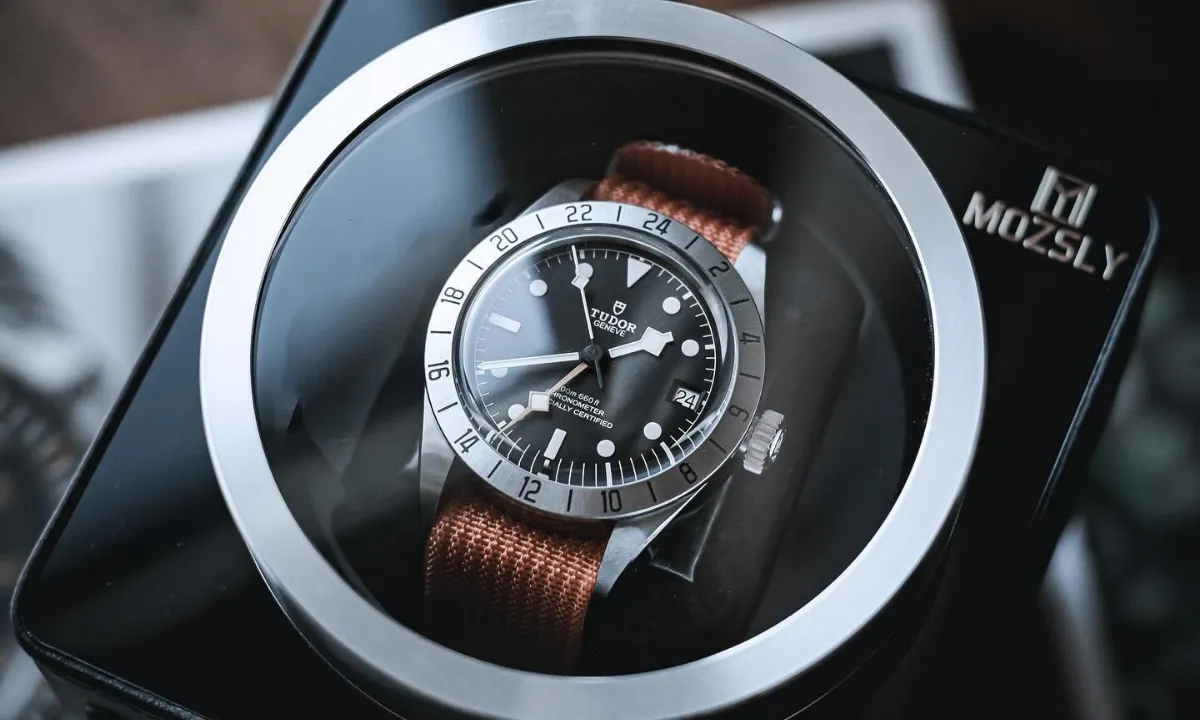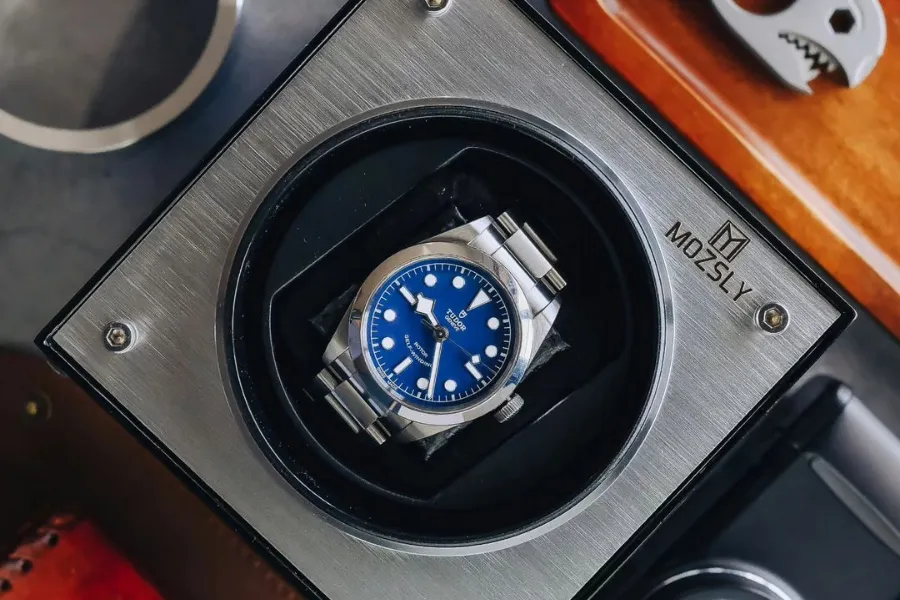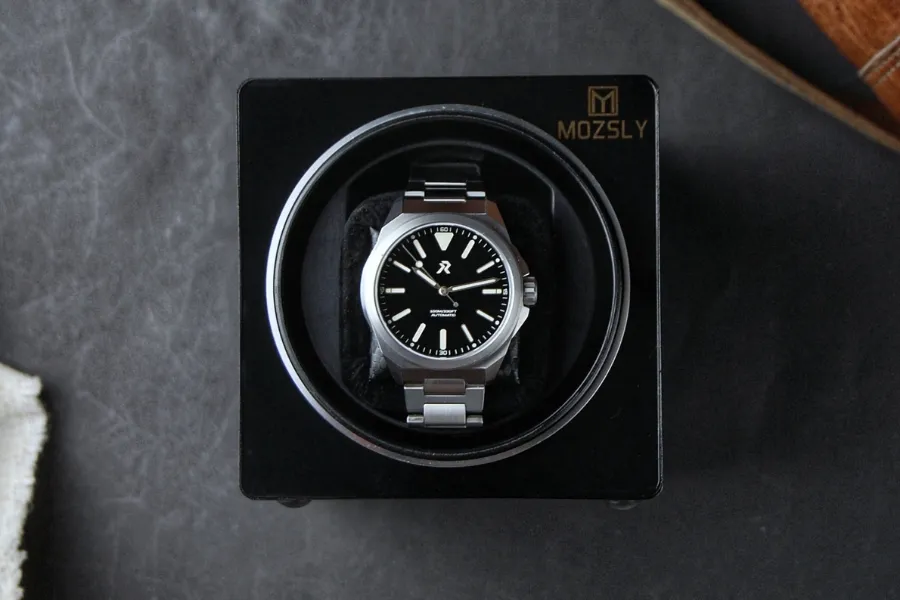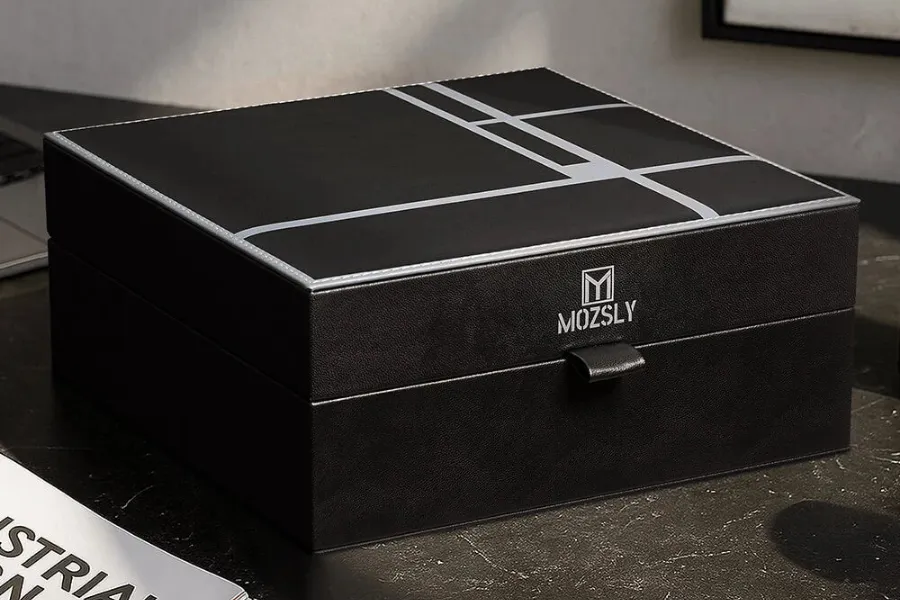Share This Post
Introduction
What happens if you forget to wind your automatic watch and leave it on your nightstand for a week? Is it dangerous for your automatic watches? Should you avoid doing so?
If you feel uncertain about these questions, welcome to the big family. Many people, including myself in the past, worry that leaving a watch unwound could damage it.
When I bought my first automatic watch, I was extremely anxious about whether letting it stay still would hurt it. I treated it ultra carefully like it’s made of glass.
Until my friend told me that it’s fine to just leave the watch on the desk for a day or two.
Before talking about more details, let’s answer the question first.
In most cases, it’s fine. Modern automatic watches can sit still for days, weeks, or even months (for some model and brand) without permanent damage.
Some problems can pop up if you leave your automatic watch unused for too long, but they’re minor and annoying — more like reminders to maintain your watch.
Your watch may show the wrong time. If it has complications, such as a perpetual calendar or moon phase, you’ll need to reset them manually. Spoiler alert: this is a chore you don’t want to do every day.
Later on, I’ll separate myth from fact on what happens when an automatic watch stops, why it’s usually harmless, and what steps you can take to care for your watch. Stay calm, and read on.
Why People Worry (And Why They Shouldn’t)?
Old-time Story Versus Modern Technology
A lot of worry comes from old stories. In the past, watch oils were made from animal fats or natural oils, which could thicken, oxidize, or gum up over time if a watch was left unused.
People saw old pocket watches seize up after years unused and assumed automatics would, too.
But modern automatic watches now use synthetic lubricants. Unlike animal- or plant-based oils, these oils are more stable and less likely to thicken or degrade when the watch is left unused.
They hold their properties much better over time and at different temperatures. That’s why most modern automatic watches tolerate sitting unused far better than old ones.
If an automatic watch sits completely still for a very long time — many months or years — the oils inside may settle or slightly lose their ideal properties.
This can lead to a bit more friction and wear when you start using it again — not catastrophic, but a little frustrating.
Stopping an automatic watch is like turning off a car engine overnight. A car isn’t harmed just by sitting parked. Leave it too long without driving and small issues can develop, but these are fixable.
What Actually Happens When Your Watch Stops
An automatic watch gains power from a semi-circular weight called rotor. It moves inside the watch case, spins with your wrist movements.
That motion winds the mainspring that stores energy to power the gear train, which is a set of moving gears that keep time.
When you stop wearing the automatic watch, the mainspring simply unwinds and no longer provides energy. And that’s all.
Your watch does not break just because it’s staying still. Gears don’t snap, and teeth don’t grind away when the watch rests. Wear happens when moving parts operate, not when they sit idle.
I once left an automatic watch in a drawer for six months. After some rewinding, it worked fine. I just needed to reset the time and date.
Modern automatic watch movements are built to handle stops. Staying still may bring some inaccuracy, but won’t cause any huge damage.
Safe Storage Timeframes You Can Trust
You can apply different maintaining methods to your automatic watches based on how long they remain still. Here’s a simple breakdown so you don’t have to guess.
Days to Weeks: Completely Safe
If you wear an automatic watch occasionally, and it stops after a few days or a couple of weeks, there’s nothing to worry about.
I know that because I’ve encountered the same scenario. I once left my automatic watches in my office for one week without rewinding, and it just stopped after running out of power. No issues or damage were dealt to my watches.
If you’re in the same situation as me, nothing special is needed. Simply wind the watch manually or use a watch winder, then set the time as needed before wearing it again.
Months: Still Generally Fine
It’s still typically okay to leave a self-winding automatic watch still for a few months.
Over longer periods, oils can slowly thicken, but this is gradual and not urgent.
You can wind it once a month to keep the oil circulating slightly and prevent any small particles from becoming stuck in one place.
If you’re unsure about this, seeking advice from a watch professional is always best.
Years: When to Pay Attention
If an automatic watch remains unused for several years, that’s when maintenance becomes crucial. Lubricants can slowly lose viscosity, and your watch may drift from accurate time.
But this is more like a reminder to schedule a service for your automatic watch, not an urgent problem.
Most watchmakers recommend servicing automatic watches every 3–5 years to clean and refresh lubricants. This guidance applies whether you wear your automatic watch daily or store it.
If you wonder how long automatic watches last after being fully wound, or what should you do after it stops, you can check the manual or contact the manufacturer.
Smart Storage Practices That Actually Work
You don’t need fancy equipment to maintain your automatic watches. Simple habits are enough to protect them.
Ideal Storage Conditions
- Dry place: avoid areas with high humidity, such as basements or bathrooms. Moisture corrodes metal or clouds crystals.
- Moderate temperature: avoid heat or freezing. Extreme changes stress seals and oils.
- No magnets: keep your automatic watch away from magnetic objects like speakers, chargers, or magnetic clasps, as they can affect the timing. Watch winders will also be affected by magnetic field sometimes, so keep them away from these things too.
- Watch winders: wind and store your automatic watches at the same time, killing two birds with one stone.
- Real-world example: a bedroom drawer or a small pouch in a closet is usually fine.
- For daily-wearing automatic watches: consider watch stands — they’re easy to access and can also serve as a decent bedroom decoration.
The Monthly Wind Rule
If you’re unsure how often to wind stored automatic watches, a typical method is to wind them once a month. You can also read this article to help you decide.
Think of it like light exercise for the movement — better than nothing.
If your automatic watch has a manual winding system, gently turn the crown clockwise approximately 20–30 times, or until you feel slight resistance.
Don’t force it. If it’s fully wound, stop. If it’s a pure self-wind without manual winding, give it a few gentle shakes and then wear it for a few minutes to charge.
Read your automatic watch’s user manual or ask a pro like the manufacturer before you do it yourself.
If you aren’t confident, it’s a good idea to have a watchmaker do it for you.
Simple Decision Guide
Here’s a quick plan you can use right now based on how often you wear your automatic watch:
- Daily: no special care is needed. Your wrist is the best watch winder.
- Weekly: it’s fine to leave your automatic watch unwound between wears.
- Monthly: wind once a month is suggested.
- Multi-year: plan service every 3–5 years and consider occasional winding using a watch winder.
When a Watch Winder Makes Perfect Sense
What’s a watch winder? It’s a small device that gently rotates your automatic watch to keep the mainspring wound and complications running when not worn.
It’s convenient, but not essential. Owning a watch winder depends on your needs.
You can match these scenarios listed below to help you make decisions.
Perfect Scenarios for Watch Winders
If you:
- Own several automatic watches (typically over 3-4) or have a huge collection, want an easy way to maintain and manage them.
- Want to showcase your collection of automatic watches in a stylish way while ensuring they are always fully powered.
- Have automatic watches with complex complications like perpetual calendars, moon phases, or multiple time zones that are a pain to reset when they stop.
- Want the automatic watch always ready to wear with the correct date/time.
- Want something to help you maintain your automatic watches, freeing you from the fuss.
Then you should consider getting a watch winder for automatic watches and yourself.
One of my friends has an Omega automatic watch with a calendar function. He told me that one day he left it in the drawer because he was very tired after work.
He forgot it completely till 6 months later. No harm was done to it, but he had to go through a series of tedious processes to reset the calendar.
I recommended a watch winder to help avoid this in the future.
So the question is: which one should he (and you) choose?
Watch Winder Recommendation: the Wanderful Mozsly
Now you might be thinking: okay, I probably need an automatic watch winder since I don’t want to wind my automatic watch manually or recalibrate the complications after it stops, that’s too much of a hassle.
You go shopping with this thought in mind, and immediately feel overwhelmed by a bunch of different types. How should you choose, and what’s best for you?
The answer varies from person to person.
However, if you ask for my opinion, I’ll say the wanderful Mozsly watch winder is a solid option.
Why?
- Its exterior design is simple but elegant, nice to watch, and decorate your room.
- It’s not very expensive — around $89.99 for a single watch winder and 159.99$ for a double watch winder.
- The Japanese ultra-quiet and durable motor inside makes it really quiet, even for a bedroom.
- It offers USB power and a wireless battery option for flexible placement, allowing you to build a modular storage system.
- The telescopic pillow securely fits many watch sizes.
- It features multiple rotating directions and four TPD presets, ranging from 650 to 1250, making it suitable for any watch weight.
You can see that it allows you to try different settings and modes to find the best winding pattern for your automatic watches.
That’s why they’re handy for watch collectors or anyone who dislikes resetting watches like you and my friend.
Remember that Omega watch I mentioned before? My friend later took my advice and immediately bought a Mozsly watch winder.
Later, when I visited his home, he was very grateful for my advice and told me, “Mozsly has really made my life much easier. It saves me a 20-minute reset when I pull my automatic watch out for a night out.”
I can understand that feeling, since I use it too.
I have some Mozsly automatic watch winders on my desk. They’re not only watch winders, but also interior decorations.
It’s really a pleasure to watch my automatic watches inside them, winding peacefully and perfectly.
Cost vs. Convenience Analysis
Ask yourself: how much is time saved worth to you?
- If you have a simple automatic watch and don’t mind winding it manually, that’s fine.
- If you juggle many automatic watches or have one with complicated functions, a watch winder can be worth the price.
- If you’re a person like me who is tired of your automatic watch stopping because it has no power, consider getting a watch winder. It will save you a lot of time.
Overall, choosing a watch every day should be a pleasure, not a burden.
A watch winder will free you from worrying about your automatic watch and all the manual-winding fuss, making your life much easier.
Warning Signs vs. Normal Behavior
Most post-storage issues are normal. However, there are still a few signs that you should pay attention to.
What’s Normal After Storage
- Need to reset the time and date.
- Slight accuracy changes for a day or two as the movement settles.
- The automatic watch stops and starts fine after winding.
Additionally, it is advisable to bring your automatic watches in for professional service every few years, whether you use them or not.
You can consult with a professional, such as the manufacturer of your watch or a trustworthy watchmaker, to gain a better understanding of the overall situation with your automatic watch.
When Professional Service Is Needed
If you notice your automatic watches having problems like:
- Accuracy worse than about 30 seconds per day (or what your manual lists).
- Difficulty winding or the crown feels gritty.
- Visible moisture or fog under the crystal.
- Strange noises or a movement that won’t run after winding.
It’s time to find the watchmaker.
But no need to scream or worry like “oh my gosh, my precious watch is doomed because of me”. These are maintenance or repair signs, not storage emergencies.
Conclusion: What to Do Right Now
Now you know all about your watches.
You’ve learned that modern automatic watches are way more resilient than vintage ones. Leaving them unwound won’t usually harm them.
You also know what safe storage timeframes are.
Quick recap:
- Days and weeks: Not a huge problem, typically.
- Months: Fine with monthly winding.
- Years: No watch-destroying catastrophe will happen, but it may need some service and maintenance.
Remember to wind your automatic watch once a month if it is stored for an extended period, like half a year or longer.
You can also consider buying a watch winder to make your life easier. It is extremely convenient for watch collectors or those who own complex watches with functions like the moon phase.
If you wear your automatic watch daily with very few of them, like one or two, a watch stand is more suitable for you.
Either way, Mozsly has what you need. Check out our Watch Winder or Solid Wood Watch Display Stand to find the one that best fits your needs.
Storage strategy is also very important. Decide your strategy based on your own situation.
- Casual wearer: wind monthly and store in a dry place. A watch winder can also be very handy if you don’t plan to wind your automatic watches yourself.
- Collector: consider a watch winder to keep watches ready and reduce fiddling.
- Daily user: wear it as usual — the best care is regular use.
I hope this calms your worries. I used to treat my watches like delicate flowers, afraid to let them sit. Now I relax a bit more.
Monthly winding or a nicely made watch winder, like Mozsly’s, a good drawer, and quality service every few years keep things running smoothly.
Got an automatic watch sitting in a drawer right now? Try winding it once using a watch winder and wearing it for a day. You’ll probably be pleasantly surprised by how easy it all is.
Related Post's
Featured Video
Provide an email subscription feature for users to sign up for updates.
Follow the world of watches and cigars for exclusive content!
By subscribing to our newsletter, you will be the first to receive notifications of our latest articles, popular posts and special events.








